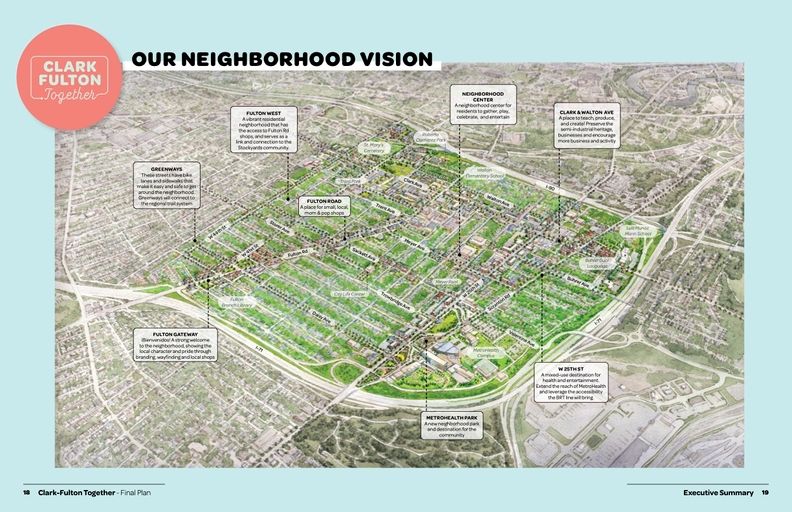Cleveland City Planning Commission Oks Investment Frameworks for Clark-Fulton Neighborhood, West 25th Street Corridor

Michelle Jarboe, Crain's
Two interconnected plans approved by the Cleveland City Planning Commission promise to shape development on the city's West Side, particularly in the diverse and densely populated Clark-Fulton neighborhood.
On Friday, Oct. 15, the commission gave a unanimous thumbs-up — and applause — to the neighborhood's first-ever master plan, a 556-page document called Clark-Fulton Together. In a separate vote, members signed off on 25 Connects, a Greater Cleveland Regional Transit Authority plan for rethinking transit and land use along the West 25th Street corridor.
The plans will serve as a framework for investments in Clark-Fulton as growth spreads south from Ohio City and Tremont and ripples outward from the MetroHealth System's main campus, where a $1 billion makeover is underway. As community leaders look at ways to build up housing, support businesses and better link residents in the area to jobs, RTA is planning a bus rapid-transit line along a 3-mile span of West 25th, from Detroit Avenue into Old Brooklyn.
"The neighborhoods you get are the neighborhoods that you plan for, right?" Ricardo León, executive director of Metro West Community Development Corp., said during the public meeting. "It's only going to be as good as the planning."
The Clark-Fulton plan is the fruit of two years of work, including extensive discussions with residents. RTA's West 25th Street plan also involved substantial community outreach, despite the formidable challenges of bringing people together during a global pandemic.
The planning commission, which has been meeting virtually, marked the significance of the votes with a rare in-person hearing. Members gathered before a small audience in a theater at the recently opened Pivot Center for Art, Dance and Expression on West 25th.
"This is the culmination of a very long journey," said Freddy Collier, the city's planning director, at the start of the meeting.
Metro West commissioned the master plan through a partnership with MetroHealth, the Cleveland Foundation, the city and Ward 14 Councilwoman Jasmin Santana.
The report stresses the importance of housing — fixing up existing homes, developing a wide variety of new homes, creating paths to homeownership and ensuring long-term access to affordable housing through a mechanism like a community land trust.
Investing in businesses and buildings along key commercial corridors is another major priority.
The team identified a handful of target sites to illustrate development potential in Clark-Fulton, which covers roughly one square mile of the city. The neighborhood is bounded by Clark Avenue on the north side, Scranton Road to the east, West 44th Street to the west and Interstate 71 to the south.
A multi-block area north of Clark could serve as a hub for artists and makers, for example. At the southwestern end of the neighborhood, properties along Fulton Avenue might become part of a new gateway to the district.
And spinoff development already is springing up near MetroHealth as the hospital system replaces aging buildings and pulls its facilities back from West 25th to make room for a 12-acre park. That park will include a half-mile-long, serpentine trail, said master-plan consultant Woo Kim, a principal with Philadelphia-based planning and design firm WRT.
"We wanted to make sure that this is a park that is integrated into the neighborhood," said Greg Zucca, MetroHealth's director of economic and community transformation.
During an interview, Zucca described the plan as a collective agreement about priorities and strategies for addressing the neighborhood's needs.
"While this final draft is being adopted, it's just the beginning," he said. "And we know that the plan is going to have to continually evolve."
Clark-Fulton is one of the focal points of Cleveland Mayor Frank Jackson's neighborhood transformation initiative, a public-private revitalization push launched in 2017. It is also a city target area for affordable-housing investments, drawing on federal money flowing through the state.
And the neighborhood will be a pilot location for Cleveland's new, form-based zoning code, which city officials hope to roll out in early 2022. The planning commission is set to hear an informational presentation about the code at its next meeting, on Nov. 5.
Just over 12,800 people live in Clark-Fulton, which is home to a high concentration of Hispanic residents. The master plan notes that 40% of neighborhood residents are poor. The median family income is $28,175, and close to 70% of adults have no college education.
Collier said that the city and its partners are increasingly attuned to how quality of place impacts quality of life — and longevity.
"Health starts where you live, work and play," he told the commission. "So the social determinants of health framework is embedded throughout this plan."
MetroHealth aims to finish its campus transformation by 2025.
That timeline dovetails with RTA's planning for West 25th, where the enhanced bus system could open in 2026.
Design work for the improved MetroHealth Line should begin next year, said Maribeth Feke, the transit agency's planning director. Construction could be a $40 million to $60 million undertaking.
RTA has allocated money for engineering in its 2022 capital budget and is looking at the Federal Transit Administration's Small Starts grant program as a potential funding source for the project.
The 25 Connects plan examines much more than bus routes, bike lanes, streets and foot traffic, though.
Canadian consultant Stantec dug into zoning issues, development potential and barriers to investments along the corridor. Seventh Hill, a local consulting firm, solicited feedback from residents of all five neighborhoods that touch the study area.
Most of the real estate along the corridor is crying out for transit-oriented development, said Craig Sklenar, a Stantec project manager.
The report suggests that West Side community development corporations should work together to coordinate development; that public officials ought to come up with better zoning and new funding mechanisms to incentivize transit-centric projects; and that there's a need for a program to help people purchase low-cost homes in Clark-Fulton and the adjoining Brooklyn Centre neighborhood.
After the commission's votes, Santana said that plans — and the last two years of collaboration — have left her feeling hopeful about Clark-Fulton's future.
"This is a legacy that we're leaving behind," she said.
